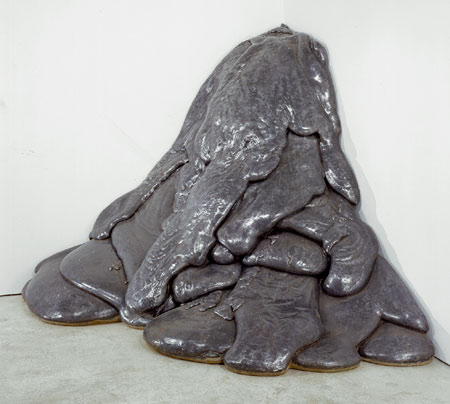
I recently attended Redcat’s exhibition Everyday Miracles featuring the work of contemporary Asian female artists Hamra Abbas, Ringo Bunoan, Chen Hui-Chiao, Shilpa Gupta, Kan Xuan, Minouk Lim and Jewyo Rhii. The show uses a variety of media including sculpture, video, photography and installations to explore themes of race, society and politics—along with the miraculous—across contemporary Asia through quotidian materials and various elements of the everyday.
I was particularly intrigued by a photographic work by Hamra Abbas entitled Paradise Bath of 2009. Abbas was born in Kuwait and now lives and works in Islamabad and Boston. Traditionally Abbas works in sculptural forms but for this piece she hired a photographer, Serkan Taycan to take the shots. The photos depict a white female being luxuriously and sensuously bathed by a darker woman in an ancient Ottoman Bath House in Thessaloniki, Greece. Interestingly, this was the only piece in the show which had an accompanying description below the work’s tombstone information. These images intend to subvert the archetypal Orientalist scene and the female nude to investigate themes of Greece’s muslim past, highlighting issues of race, memory and power. The work also examines notions of purity and washing which are essential in Islam. The use of female nudity is also noteworthy considering Abbas is a Pakistani artist and the work deals with Islamic themes.

Another provoking piece is Shilpa Gupta’s Untitled Don’t See Don’t Hear Don’t Speak from 2008. The three photos depict dozens of young Indian boys dressed in western clothing, one wearing a large, gaudy gold watch, covering one another’s eyes, mouths, and ears in various poses. These over life size digital prints are printed on flex material, giving the piece the feeling of a mural. Previously Gupta has photographed persons of all ethnicities doing these same gestures and plastered the photos on billboards throughout Bolzano, Italy. Gupta generally works in diverse media including interactive video, websites, objects, photographs, sound and public performances, As her website explains, her work “probe[s] and examine[s] subversively such themes as desire, religion, notions of security on the street and on the imagined border.” Don’t See Don’t Hear Don’t Speak plays on the story of the three monkeys with the adage see no evil, hear no evil, speak no evil which has been associated with Mahatma Gandhi. Gupta uses the allusion to comment on the tendency towards obliviousness and senselessness in the face of capitalism and strident individualism.
Everyday Miracles is a successful show in that it showcases provocative, avant-garde work by artists who do not fit into the often male dominated world of contemporary art—particularly in Asian countries. The works in Everyday Miracles move beyond a feminist discourse into a wider arena of social and political commentary using fresh alternative media. From Chen Hui-Chiao’s use of ping-pong balls in Here and Now: Sound Falling II to Ringo Bunoan’s wood pallets which make up Bridge, the works presented are vibrant and have an urgency in their execution which is difficult to ignore.
















